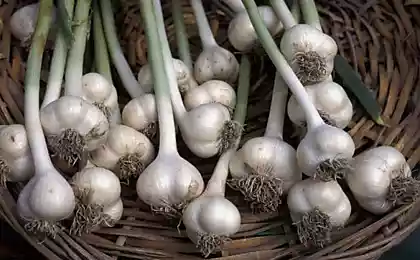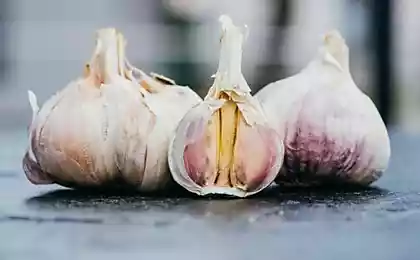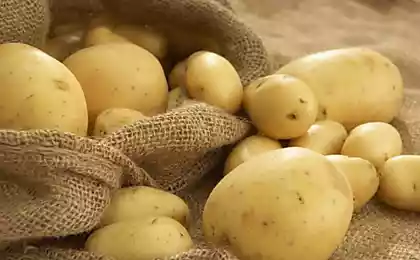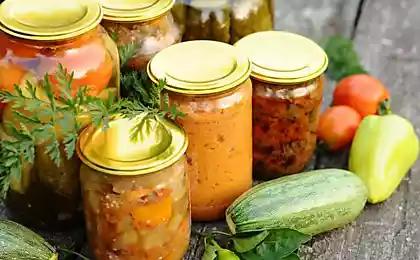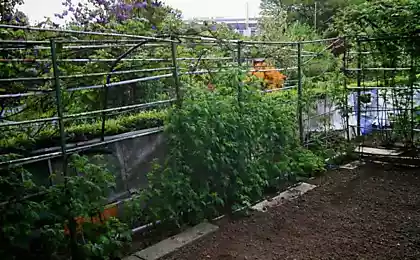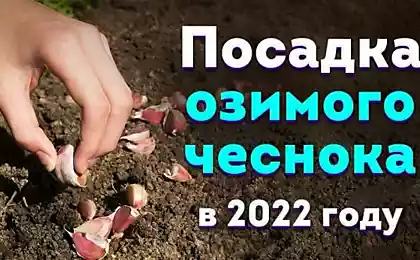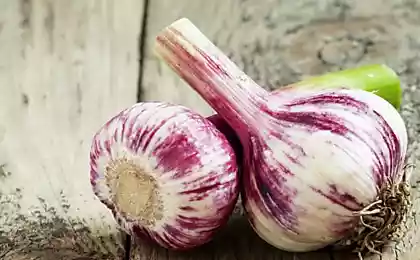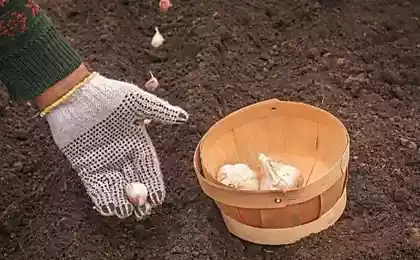158
Grandma always said that when it comes time to dig up garlic, you will understand, there is a sure sign.
Gardeners grow on beds mainly two types of garlic: winter and spring. The first is planted in the winter, and the second in the spring. Therefore, beginners are interested in when to dig up garlic planted at different times of the year.

Winter garlic is planted in autumn until the first frosts, when the entire harvest has already been harvested from the garden. For him, choose a suitable bed, dig it up and immerse the selected teeth in the soil. In the spring, when the snow melts, it will immediately give the first shoots. In summer, winter garlic begins to form arrows - future inflorescences. When the arrows are twisted, they are broken at the very base. This is done so that the vegetable does not waste its energy on flowering and ripening of seeds, and all useful elements accumulate in the head.

Young arrows are very tasty, but experienced housewives advise leaving one inflorescence in different areas of the garlic bed to determine the degree of ripening of the vegetable and its readiness for harvest. The arrow stretched out and straightened out - it's time to dig out the garlic!
Some summer residents wait for the seeds to open, but this is an optional condition for extracting garlic heads from the ground. You can navigate the state of the lower leaves on the stems: the leaves dried up to the fourth - you can remove the vegetable from the garden.

The arrows make sense. But what to do with winter garlic that does not bloom and does not let out the shooter? In this case, you need to watch the color of the leaves. If they turned yellow and began to dry, do not hesitate to dig out the vegetable.
Care for garlic Spring garlic is planted in early spring. But in areas with a temperate climate, where there are no severe frosts, some gardeners practice planting varietal cloves for the winter. This contributes to the rapid germination of the vegetable in early spring. But it should be remembered that a strong cold such garlic will not withstand. Arrow spring garlic usually does not let and does not bloom. The degree of its ripening is determined by the condition of the plant: the leaves are massively yellowed - you can harvest.

The garlic ripening process is usually completed in July. Our ancestors focused on the church feast of Peter and Paul, which has a stable date - July 12. Garlic was excavated on the eve of the holiday or after its completion.
But the climate is gradually changing, and weather conditions can be very diverse. Therefore, when harvesting, it is necessary to focus on the condition of garlic heads located in the ground. With high humidity, vegetables can begin to rot.

In such cases, it is recommended not to delay the removal of the heads from the soil to prevent their further deterioration. Sometimes you have to dig up garlic even in early July to maximize the harvest. Watch the plants: they will tell you that it is time to extract them.
To pull the garlic out of the ground without damaging the head, you need to use a shovel. Then the vegetable will be better preserved. The roots of plants should be slightly shaken off the soil. If the ground is strongly stuck to the heads and firmly holds, then you can wash away the dirt under the stream of water. It is impossible to soak garlic for a long time.

The collected garlic is tied or woven into bundles and hung in a well-ventilated place, protected from rain and sun, heads down. After a few days, the entire crop is moved to the attic so that the heads dry completely. When the stems and leaves are completely dry, they must be pruned. After that, the garlic is sorted, depositing the selected heads for the next planting, and everything else is put in bags for further consumption.

Winter garlic is planted in autumn until the first frosts, when the entire harvest has already been harvested from the garden. For him, choose a suitable bed, dig it up and immerse the selected teeth in the soil. In the spring, when the snow melts, it will immediately give the first shoots. In summer, winter garlic begins to form arrows - future inflorescences. When the arrows are twisted, they are broken at the very base. This is done so that the vegetable does not waste its energy on flowering and ripening of seeds, and all useful elements accumulate in the head.

Young arrows are very tasty, but experienced housewives advise leaving one inflorescence in different areas of the garlic bed to determine the degree of ripening of the vegetable and its readiness for harvest. The arrow stretched out and straightened out - it's time to dig out the garlic!
Some summer residents wait for the seeds to open, but this is an optional condition for extracting garlic heads from the ground. You can navigate the state of the lower leaves on the stems: the leaves dried up to the fourth - you can remove the vegetable from the garden.

The arrows make sense. But what to do with winter garlic that does not bloom and does not let out the shooter? In this case, you need to watch the color of the leaves. If they turned yellow and began to dry, do not hesitate to dig out the vegetable.
Care for garlic Spring garlic is planted in early spring. But in areas with a temperate climate, where there are no severe frosts, some gardeners practice planting varietal cloves for the winter. This contributes to the rapid germination of the vegetable in early spring. But it should be remembered that a strong cold such garlic will not withstand. Arrow spring garlic usually does not let and does not bloom. The degree of its ripening is determined by the condition of the plant: the leaves are massively yellowed - you can harvest.

The garlic ripening process is usually completed in July. Our ancestors focused on the church feast of Peter and Paul, which has a stable date - July 12. Garlic was excavated on the eve of the holiday or after its completion.
But the climate is gradually changing, and weather conditions can be very diverse. Therefore, when harvesting, it is necessary to focus on the condition of garlic heads located in the ground. With high humidity, vegetables can begin to rot.

In such cases, it is recommended not to delay the removal of the heads from the soil to prevent their further deterioration. Sometimes you have to dig up garlic even in early July to maximize the harvest. Watch the plants: they will tell you that it is time to extract them.
To pull the garlic out of the ground without damaging the head, you need to use a shovel. Then the vegetable will be better preserved. The roots of plants should be slightly shaken off the soil. If the ground is strongly stuck to the heads and firmly holds, then you can wash away the dirt under the stream of water. It is impossible to soak garlic for a long time.

The collected garlic is tied or woven into bundles and hung in a well-ventilated place, protected from rain and sun, heads down. After a few days, the entire crop is moved to the attic so that the heads dry completely. When the stems and leaves are completely dry, they must be pruned. After that, the garlic is sorted, depositing the selected heads for the next planting, and everything else is put in bags for further consumption.
Remove this thing from your home to restore well-being and peace of mind, otherwise there may be consequences.
How to salt lard so that it is soft and not afraid of any heat, the way of Ukrainian volunteers





